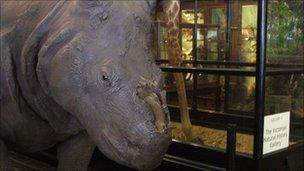Rosie the rhino's horn stolen from Ipswich Museum
- Published

The stuffed rhino's horn was stolen by thieves overnight
Thieves have broken into Ipswich Museum and stolen the horn from a stuffed rhino on display.
Despite receiving warnings of gangs targeting museums and auction houses for rhino horn, the museum in the High Street was broken into on Thursday.
Two men, believed to have stolen the horn from Rosie the Rhino and another rhino skull, were seen leaving in a silver car at about 00:25 BST.
The museum service said it had been confident its security was good.
Warnings issued
The collections manager at Colchester and Ipswich Museum Service, Jayne Austin, said: "It had been reviewed by the National Security Advisor in 26 July 2010 who stated that 'security arrangements at this venue conform to the guidelines set by the Department of Culture Media and Sport'."
Earlier this week the Metropolitan Police warned that gangs were visiting museums on reconnaissance with a view to carrying out thefts of rhino horn.
"We received no specific warning from the Met," said Ms Austin.
"We did, however, receive warning from museums sector sources.
"A notice was also received via Essex County Council from Essex Police on 7 July 2011."
Ms Austin said in response to the warnings the museum service made sure that its front of house staff were aware and vigilant to any suspicious behaviour.
She said after discussions a decision was taken to leave Rosie on open display in Ipswich Museum as she was one of the most popular exhibits there.
In February a rhino head, worth more than £50,000, was stolen from Sworders Auctioneers in Stansted Mountfitchet.
At the time Essex Police said the rhino's horn could be ground down to be used in black-market Chinese medicine.
Earlier this month, Europol said it had uncovered an Irish organised crime group illegally trading rhino horn worth tens of thousands of euros as far afield as China.
Rhino poaching has also surged, with 200 of the endangered animals killed in South Africa last year.
- Published25 July 2011
- Published22 February 2011
- Published7 July 2011
- Published21 September 2010